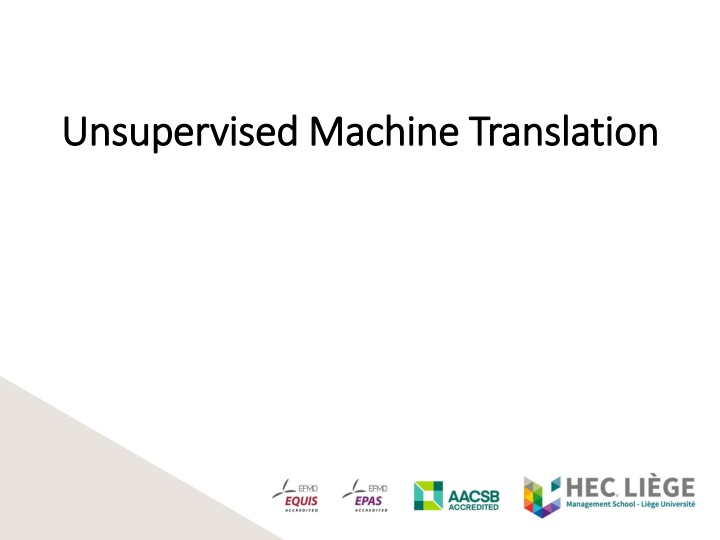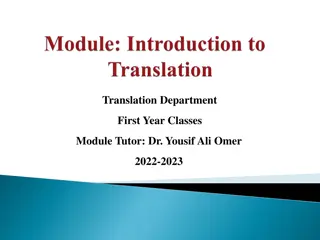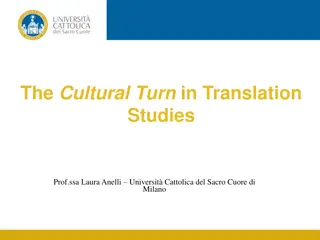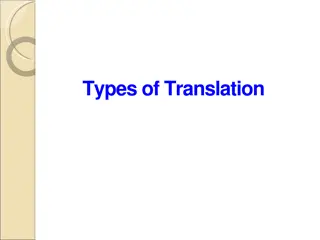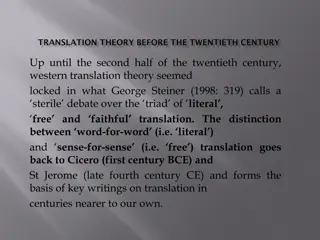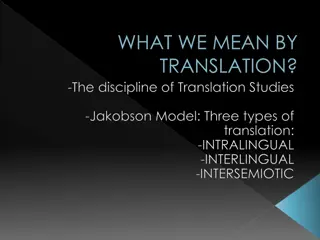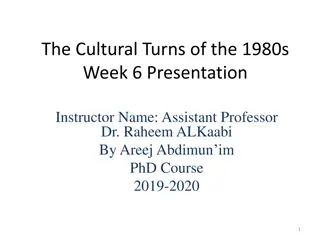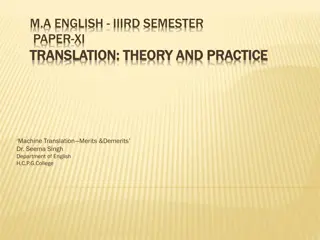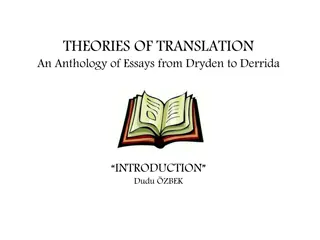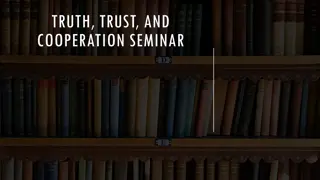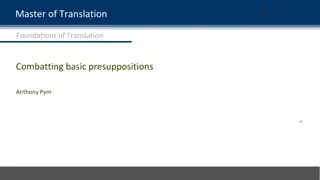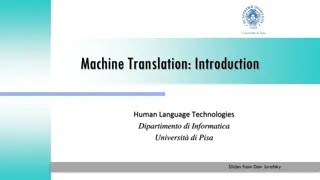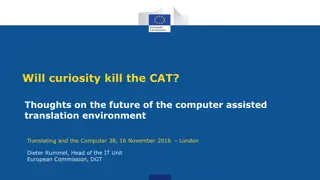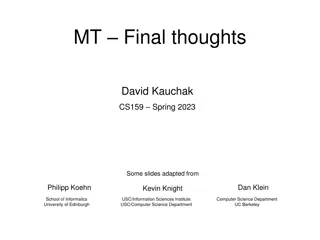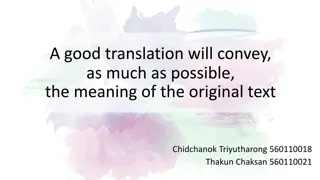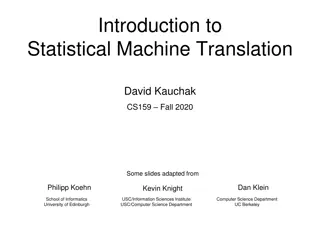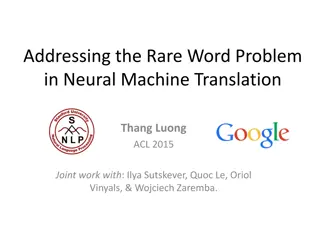Unsupervised Machine Translation Research Overview
Delve into the world of unsupervised machine translation research focusing on the challenges of low-resource languages, lack of parallel corpora hindering system development, and the solutions and efficient approaches adapted by researchers. Explore the agenda covering semi-supervised and unsupervised machine translation techniques proposed by leading researchers in the field.
Download Presentation

Please find below an Image/Link to download the presentation.
The content on the website is provided AS IS for your information and personal use only. It may not be sold, licensed, or shared on other websites without obtaining consent from the author.If you encounter any issues during the download, it is possible that the publisher has removed the file from their server.
You are allowed to download the files provided on this website for personal or commercial use, subject to the condition that they are used lawfully. All files are the property of their respective owners.
The content on the website is provided AS IS for your information and personal use only. It may not be sold, licensed, or shared on other websites without obtaining consent from the author.
E N D
Presentation Transcript
Unsupervised Machine Translation Unsupervised Machine Translation
Brief Overview & Research Group Brief Overview & Research Group Assoc. Professor, HEC Li ge, University of Li ge Belgium Head Quantitative Methods Unit, HEC Li ge Associate Editor, COMIND, Elsevier
Brief Overview & Research Group Brief Overview & Research Group PhD candidates 1 open position
Why unsupervised? Why unsupervised? Statistical, Neural MT systems Require large parallel corpora for training Learn mapping source target language mapping Existing, reasonably large parallel corpora English, Chinese, Arabic, German However, a plethora of low resource languages Vietnamese, Malay, Indonesian, Croatian, .
Why unsupervised? ( Why unsupervised? (cont cont) ) Lack of parallel corpora Hinders low resource language MT system development Vietnameses Indonesian? Croation Malay Solution? For low resource language pair, e.g. Vietnamese Indonesian Manual creation, curation of large parallel corpora However, Costly Time-consuming
Why unsupervised? ( Why unsupervised? (cont cont) ) More efficient and scalable approaches? Exploit existing resources, e.g. Wikipedia MT with minimal supervision Semi-supervised approach Unsupervised MT
Agenda Agenda This talk on current state of the art Semi-supervised MT Unsupervised MT Semi-supervised MT Back-translation (briefly), Sennrich et al., 2015 Unsupersived Word Translation Without Parallel Data, Conneau et al. 2018
Semi Semi- -supervised supervised Semi-supervised some supervision Back-translation method, Sennrich et al., 2015 Small parallel corpora, e.g. EN-FR Large monolingual corpus in FR (target language)
Semi Semi- -supervised ( supervised (cont cont) ) Translate back, from target to source, MTS Use small parallel corpora, FR EN Use MTS Translate large FR corpus into EN Results in large EN corpus EN corpus is noisy but Large
Semi Semi- -supervised ( supervised (cont cont) ) Concatenante to create parallel corpus Small English + Large (noisy) English Small French + Large French Train MT system on parallel corpus EN-FR Much better performance Vs. training on small EN-FR corpus
Semi Semi- -supervised ( supervised (cont cont) ) Process can be repeated Previous example: Use FR data for better EN-FR MT But if additional EN sentences available Train an EN-FR system Use model to improve FR-EN performance Simple technique Good performance in practice
Weakly-Supervised & Unsupervised
Weakly Weakly- -supervised supervised Weakly-supervised MT Basis for unsupervised MT Inspired many unsupervised MT studies Seminal article: Exploting Similarities between Language for MT Mikolov et al., 2013
Word Word Embeddings Embeddings Word embeddings
Weakly Weakly- -supervised ( supervised (cont cont) ) Relies on word embeddings for source and target language E.g.: EN IT Geometrical corrspondences
Weakly Weakly- -supervised ( supervised (cont cont) ) Relies on word embeddings for source and target language E.g.: EN IT Monolingual space look similar
Weakly Weakly- -supervised ( supervised (cont cont) ) Mikolov et al. Learn a very simple, linear mapping Map EN space IT space Find matrix W such that Linear mapping outperformed neural network model Matrix W for mapping EN ES Best performance if W is orthogonal (Smith et al. 2017)
Weakly Weakly- -supervised ( supervised (cont cont) ) Approach of Mikolov et al. Learn word embeddings for 5000 word pairs in src & tgt languages E.g. EN, IT Stack them in 2 matrices X, Y, both ?5000 ? X: matrix of EN embeddings Y: matrix of IT embeddings 1st row X (Y): word embedding of 1st EN (IT) word Learn a matrix W such that
Weakly Weakly- -supervised ( supervised (cont cont) ) If W is orthogonal Closed form solution to minimization problem exists Proscrustes Problem W easily computed using SVD as Given W, for source word s (not in dictionary),
Unsupervised Unsupervised From the initial space X can be mapped onto Y via rotation But large number of dimensions in practice Cannot simply map by rotating Unsupervised learning of mappings?
Unsupervised ( Unsupervised (cont cont) ) If WX and Y align perfectly Indistinguishable Advesarial game formulation Train a discriminator, predicts words, z z X predict as source words (source =1) z Y predict as target words (source =0)
Unsupervised ( Unsupervised (cont cont) ) Train the mapping W Makes discriminator believe that Y is from source (source = 1) Makes discriminator believe that X is from target (source = 0) W generates fake items Discriminator has access to correct info (source & trgt words) Sends signals to W, W learns
Unsupervised ( Unsupervised (cont cont) )
Unsupervised ( Unsupervised (cont cont) ) Enhancement Use high quality word translations from Adversarial training Apply Proscrustes Repeate until convergence Performance Improvements
Summary Summary Generate monolingual embeddings Align embeddings using Adversarial training Improvement Select high quality pairs from Adversarial training Apply Proscrustes Generate translations
Language Modelling Language Modelling Learn statistical representation of languages E.g. predict next most likely word I like to eat ____ OpenAI Transformer network (Vaswani et al., 2017)
SYSTEM PROMPT (HUMAN-WRITTEN) In a shocking finding, scientist discovered a herd of unicorns living in a remote, previously unexplored valley, in the Andes Mountains. Even more surprising to the researchers was the fact that the unicorns spoke perfect English. MODEL COMPLETION (MACHINE-WRITTEN, 10 TRIES) The scientist named the population, after their distinctive horn, Ovid s Unicorn. These four-horned, silver-white unicorns were previously unknown to science. Now, after almost two centuries, the mystery of what sparked this odd phenomenon is finally solved. Dr. Jorge P rez, an evolutionary biologist from the University of La Paz, and several companions, were exploring the Andes Mountains when they found a small valley, with no other animals or humans. P rez noticed that the valley had what appeared to be a natural fountain, surrounded by two peaks of rock and silver snow. P rez and the others then ventured further into the valley. By the time we reached the top of one peak, the water looked blue, with some crystals on top, said P rez. P rez and his friends were astonished to see the unicorn herd. These creatures could be seen from the air without having to move too much to see them they were so close they could touch their horns. While examining these bizarre creatures the scientists discovered that the creatures also spoke some fairly regular English. P rez stated, We can see, for example, that they have a common language, something like a dialect or dialectic. .
Conclusion Significant progress in MT Unsupervised MT But Translation of syntactically complex texts/discourses Evaluating translation quality: is BLEU score relevant? How to choose between multiple possible translations How to incorporate human feedback?
